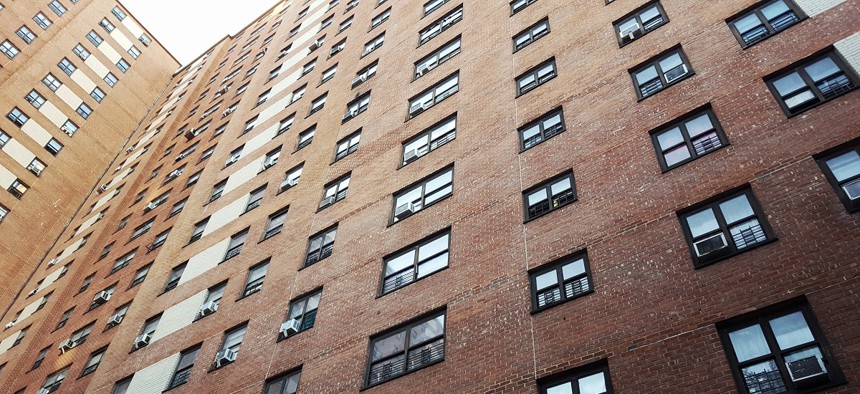Opinion
Opinion: Those who live in NYCHA can put an end to its corruption
An argument for the creation of Resident Management Corporations to manage the nation’s largest public housing system.

A New York City Housing Authority building in Manhattan’s Harlem. (Busà Photography)
In early February, the news of 70 bribery and extortion arrests of current and former NYCHA employees across more than 100 public housing developments came as no surprise to residents and advocates who have been witnessing the conditions for years. Despite strict contracting requirements, the housing authority is plagued by limited operating funding leading to a scenario where the head often doesn't know what the feet are doing. While we must continue to fight for more funding for public housing and real transparency, one solution is to turn to the residents.
In 1971, public housing residents at Boston’s Bromley-Heath Development formed an organization known as a Resident Management Corporation in response to years of corruption and mismanagement that made them say enough is enough. RMCs are resident-formed organizations created to manage public housing. With leaders like activist Mildred Hailey (the grandmother of the RMC movement) at the helm, within two years, Bromley-Heath became the first public housing development in the nation to be managed by its residents. Within two decades, ten other developments followed.
Both the U.S. Department of Housing and Urban Development, nongovernment organizations and Congress supported existing RMCs and encouraged new ones with legislation and resources. These efforts led to the likes of Guste Homes RMC in New Orleans, created in response to the 1980s crime wave. They went from being residents of New Orleans’ Central City neighborhood – a focal point of gang activity – to contracting with the New Orleans Housing Authority to manage safe, affordable housing in an area with an unrelenting real-estate market full of speculation, just steps from the French Quarter. The RMC in nearby Jersey City’s A. Harry Moore Homes now manages buildings in better condition than housing agency developments across the country. RMCs have even gone on to manage new housing, utilizing subsidies like the Low-Income Housing Tax Credit.
The achievements of RMCs are more than just anecdotal success stories. A congressionally commissioned study found that residents who managed developments outperformed their housing agencies on most management indicators. Vacancy rates at RMC developments were lower, and their work order processing, unit inspections, and recertifications were superior. Housing agencies only performed “better” at turnover of apartments (evictions) and RMCs were more likely to give leeway to tenants who owed rent. The study also found that those living in resident-managed developments were 11% more satisfied with their housing overall and 17% more satisfied with their building‘s maintenance. Residents also had an enhanced sense of personal responsibility and were provided more supportive services and employment opportunities. The study was completed in 1992, and more than 30 years later, New York City has no RMCs.
New York was once seen as the most progressive state in the country and its biggest city is known for trailblazing efforts in equity. Public housing in New York should embrace resident management, especially since NYCHA and other authorities have committed to becoming just voucher administrators, opening the door for private real estate via the Rental Assistance Demonstration program. By offloading management to private landlords, NYCHA has also offloaded the risk for issues like corruption and repairs. However, new management can come with its own drawbacks, as evictions, quality of work, and public housing protections continue to be a subject of concern for residents in RAD developments. But whether it's via RAD or through traditional public housing management, seeing developments as assets and not as people wanting advancement and income mobility continues to be a missed opportunity. As millions in new capital contracts come to NYCHA, the Section 3 rules, which require that the agency hire residents and contract with resident-led companies have been ignored. Had Section 3 compliance been attempted with these contracts, the corruption witnessed here would have never occurred.
New York state can begin to put residents on a path to more efficient management with our plan, “TOPA for Public Housing.” Named after the Tenant’s Opportunity to Purchase Act – which has become a popular way to rectify the governance and management issues in private market housing – this plan would create a training program covering housing management, finance, and legal aspects of housing governance as well as the incorporation process and crucial certifications and other necessary subjects. It also includes the encouragement of RMCs via a preference for projects that include them in relevant program term sheets and requirements for resident notice. There has been a movement around the country arguing that residents should not only be engaged but in control of their homes. Why should public housing households not be offered similar control and even ownership as with Community Land Trusts and TOPA? With the untransparent expansion of the RAD program and corruption that is just the tip of the iceberg, maybe it’s time for public housing residents in New York to be given a chance to thrive on their terms.
Manny Martinez is president of the South Jamaica Houses Resident Association and Iziah Thompson is senior policy analyst for the Community Service Society of New York.
